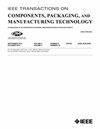Effect of Effective Curing Shrinkage of EMC on Strip Warpage During IC Encapsulation Process
IF 2.3
3区 工程技术
Q2 ENGINEERING, ELECTRICAL & ELECTRONIC
IEEE Transactions on Components, Packaging and Manufacturing Technology
Pub Date : 2024-10-30
DOI:10.1109/TCPMT.2024.3488009
引用次数: 0
Abstract
Using numerical simulation to create a digital twin for process evaluation is vital for sustainable and intelligent manufacturing, which can predict manufacturing failures and design for optimization in advance. Material characterization plays a crucial role in a convinced numerical simulation creation. Encapsulation-induced warpage is a vital issue of integrated circuit (IC) packaging. A strip of flip-chip chip-scale package (fcCSP) was chosen as the test vehicle. A Moldex3D simulation model was developed to evaluate the encapsulating process from filling to curing to cooling. The effective curing shrinkage of epoxy molding compound (EMC) can be derived from the encapsulating process. The material properties of EMC, including effective curing shrinkage, thermal shrinkage, and viscoelasticity, are considered in the warpage simulation. The simulation result correlates well with the experiment result. Regarding package design, the effect of various factors on the warpage was investigated using Taguchi’s method. Several component sizes, material parameters, and process parameters were selected as the design factors, including the chip thickness, substrate core thickness, EMC thickness, EMC Young’s modulus, EMC coefficient of thermal expansion, EMC curing shrinkage, mold temperature, and transfer pressure. The evaluation results indicate that the material properties of EMC and mold temperature are the most critical parameters for warpage control of the IC package. This study demonstrates a digital twin for the encapsulating process and provides guidance for robust package design.集成电路封装过程中电磁兼容有效固化收缩对带材翘曲的影响
利用数值模拟技术创建过程评估的数字孪生对于可持续和智能制造至关重要,它可以提前预测制造故障并进行优化设计。材料表征在一个令人信服的数值模拟创建中起着至关重要的作用。封装翘曲是集成电路封装中的一个重要问题。我们选择一条倒装芯片芯片级封装(fcCSP)作为测试载体。建立了Moldex3D仿真模型,以评估从填充到固化到冷却的封装过程。环氧成型复合材料(EMC)的有效固化收缩率可以从封装过程中得出。在翘曲模拟中考虑了电磁兼容材料的有效固化收缩率、热收缩率和粘弹性。仿真结果与实验结果吻合较好。在包装设计方面,采用田口法考察了各种因素对翘曲量的影响。设计因素包括芯片厚度、基板芯厚度、EMC厚度、EMC杨氏模量、EMC热膨胀系数、EMC固化收缩率、模具温度、传递压力等。评估结果表明,材料的电磁兼容性和模具温度是控制IC封装翘曲的最关键参数。该研究展示了封装过程的数字孪生,并为稳健的封装设计提供了指导。
本文章由计算机程序翻译,如有差异,请以英文原文为准。
求助全文
约1分钟内获得全文
求助全文
来源期刊

IEEE Transactions on Components, Packaging and Manufacturing Technology
ENGINEERING, MANUFACTURING-ENGINEERING, ELECTRICAL & ELECTRONIC
CiteScore
4.70
自引率
13.60%
发文量
203
审稿时长
3 months
期刊介绍:
IEEE Transactions on Components, Packaging, and Manufacturing Technology publishes research and application articles on modeling, design, building blocks, technical infrastructure, and analysis underpinning electronic, photonic and MEMS packaging, in addition to new developments in passive components, electrical contacts and connectors, thermal management, and device reliability; as well as the manufacture of electronics parts and assemblies, with broad coverage of design, factory modeling, assembly methods, quality, product robustness, and design-for-environment.
 求助内容:
求助内容: 应助结果提醒方式:
应助结果提醒方式:


